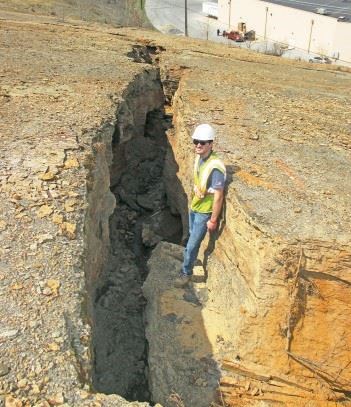By Sebastian Lobo-Guerrero, Ph.D., P.E., From American Geotechnical and Environmental Services
 On Easter Sunday, March 27, 2016, a landslide initiated in an existing rock cut located uphill from a shopping plaza in Altoona, Pa. The landslide created tension cracking along the existing rock cut, and during a period of weeks the tension cracks expanded from inches to feet (mm to meters). Survey readings indicated that portions of the slide were moving at a rate of approximately 2 in/day (5 cm/day). In addition to the shopping plaza, high voltage electric lines and an underground gas line ran along the base of the rock cut, further prioritizing the need to mitigate the failure as quickly as possible. Due to the rate at which the rock mass was sliding and the associated potential danger below, a plan was rapidly implemented to secure the hillside. The plan involved constructing a temporary rock buttress, removing most of the slide mass, securing the bedrock upslope of the tension crack with shear pins, and final reconstruction and grading of the slope. The inherent danger that quickly developed from the slide failure led to intense media coverage, with some positive and negative impacts.
On Easter Sunday, March 27, 2016, a landslide initiated in an existing rock cut located uphill from a shopping plaza in Altoona, Pa. The landslide created tension cracking along the existing rock cut, and during a period of weeks the tension cracks expanded from inches to feet (mm to meters). Survey readings indicated that portions of the slide were moving at a rate of approximately 2 in/day (5 cm/day). In addition to the shopping plaza, high voltage electric lines and an underground gas line ran along the base of the rock cut, further prioritizing the need to mitigate the failure as quickly as possible. Due to the rate at which the rock mass was sliding and the associated potential danger below, a plan was rapidly implemented to secure the hillside. The plan involved constructing a temporary rock buttress, removing most of the slide mass, securing the bedrock upslope of the tension crack with shear pins, and final reconstruction and grading of the slope. The inherent danger that quickly developed from the slide failure led to intense media coverage, with some positive and negative impacts.
Slope Failure and Preliminary Investigation
The failure of the slope was first observed when tension cracks were discovered along the top of the rock cut, which was constructed more than a decade before the failure. Once the failure was identified, the site owner quickly began an investigation and contacted The EADS Group for engineering services (slide monitoring and project coordination) and A.G.E.S. for geotechnical design of the slide remediation. The site investigation was performed as quickly as possible, and revealed that bedrock along the cut consisted of sandstone with interbedded shale with a bedding dip of about 16 degrees. The orientation of the dip was downslope along and toward the cut.
A drainage ditch was present upslope of the failure scarp, and was intended to divert water from wetlands upslope. It was noted that trees were growing along the drainage ditch. Water flow within the ditch seemed to “disappear” in the region closer to the scarp. It was believed that surface runoff had been flowing into the slide rather than following the path of the constructed drainage ditch. Water could be heard flowing within the tension cracks of the slope failure, and seepage was observed along the slope. In an effort to reduce future movement, the water in the ditch (region of groundwater infiltration) was temporarily diverted by pumping until the ditch and slide could be repaired.
Read full article here.
